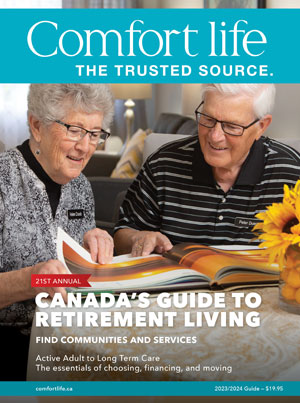Lists of reports on this page:
Find care details, insights, and insider perspectives gained from 20+ years of helping seniors and families.
What to know about this topic:
- The benefits of respite care in a Kitchener-Waterloo retirement home
- More about the costs of respite care and procuring care
- Respite care vs. other kinds of short stays
- Resources to help you make the best choice
Below, we list Kitchener-Waterloo retirement homes that offer respite care stays for seniors. Need a break from caregiving? Reach out to the communities below and learn what they offer. In Ontario, you can have respite from caregiving for up to 60 days in a row. Below the list, find out more about this, along with other information and advice.
IN-DEPTH REPORTSKitchener-Waterloo retirement homes with respite care
Hygate Active Senior Living
Resort-style retirement living in Waterloo. Hygate promotes active senior living with modern décor and amenities. Enjoy daily fitness, activity programs and fine dining. It's next level senior living.
Lifestyle Options: Apartments, Independent Living, Assisted Living
The Village at University Gates
Now welcoming our Retirement Home Residents to the Village. We offer Waterloo a range of services for today's Senior including Retirement Apartments, Assisted Living, Memory Care and Long Term Care.
Lifestyle Options: Independent Living, Assisted Living, Memory Care, Long-term care
Sifton - The Westhill
The Westhill is an inviting atmosphere of new friends and great times, with personalized support services for better living. The Westhill is conveniently located in Waterloo, near The Boardwalk shopping area.
Lifestyle Options: Independent Living
The Village of Winston Park
This elegant retirement residence in Kitchener-Waterloo offers a continuum of care from independent living apartments to assisted living, memory care and long-term care.
Lifestyle Options: Independent Living, Assisted Living, Memory Care, Long-term care
The benefits of respite care in a Kitchener-Waterloo retirement home
1. Take a break from caregiving. This is good for your mental health, and when you come back to giving care to your loved one, you’ll be better at it.
2. Retirement home staff are specially trained to deal with behaviours that are associated with Alzheimer’s Disease and other forms of dementia (if this is the case for your loved one). A side benefit of this is that you can observe staff, converse with them, and learn tips from them to help improve your daily caregiving.
3. Retirement homes’ professional care may include medical staff and other clinical aids. Many retirement homes include nursing staff, visiting doctors, and medical equipment. These factors add to your peace of mind, sure, but they can also entail better care than you provide on your own.
4. Meals and other help is included. Retirement homes offer dining services and other food services. Of course, all housework and personal care will be included or available also.
5. You and your loved one gain a window into contemporary senior living and care. If both of you have never looked at the benefits of retirement living, you’ll be amazed. There are amenities and activities, and retirement homes are vibrant places nothing like some seniors think (who carry outdated preconceptions about “old age homes”). Typically, seniors are amazed at how much they like being surrounded by people their age—along with compassionate care staff.
More about the costs of respite care and procuring care
Respite care in a retirement home like those above typically starts around $100 and can be more costly depending on the amenities offered. That’s just an overview, so consult with communities near you to learn the exact cost.
Adult day programs offer structured activities and supervision, with costs starting at around $25 an hour. These can sometimes have waiting lists, especially if they are government-run.
Home care companies also offer respite care, starting at around $45 an hour.
The local Home and Community Support Services (HCSS) makes recommendations about the type of care you need and where to get it. HCSS works closely with government-funded homes and community services and provides access to those service providers. The maximum length of stay is 60 days but you can procure up to 90 days in any calendar year.
Funding for respite care works similarly to long-term care. You pay room and board for the retirement home. Care services are covered by the province. There are guidelines covering the admission process, however you can also consider just buying your own respite care.
Respite care vs. other kinds of short stays
Any kind of short stay is a respite for families if they dedicate personal time to caring for an aging loved one.
A trial stay in a retirement home is usually a one- or two-week stay that gives you a break, and (again) lets your parent or loved one see a retirement home from the inside. seniors an insider’s look at the life of the retirement home.
A convalescent care stay is ideal after surgery or any other hospital stay. A retirement home is an ideal place for anyone 65, 75, and up who’s willing to give it a go You might see people your age—and you’ll enjoy the pampering, the convenience, and the company.
There are also guest stays, ideal for family members from out of town visiting senior loved ones.





